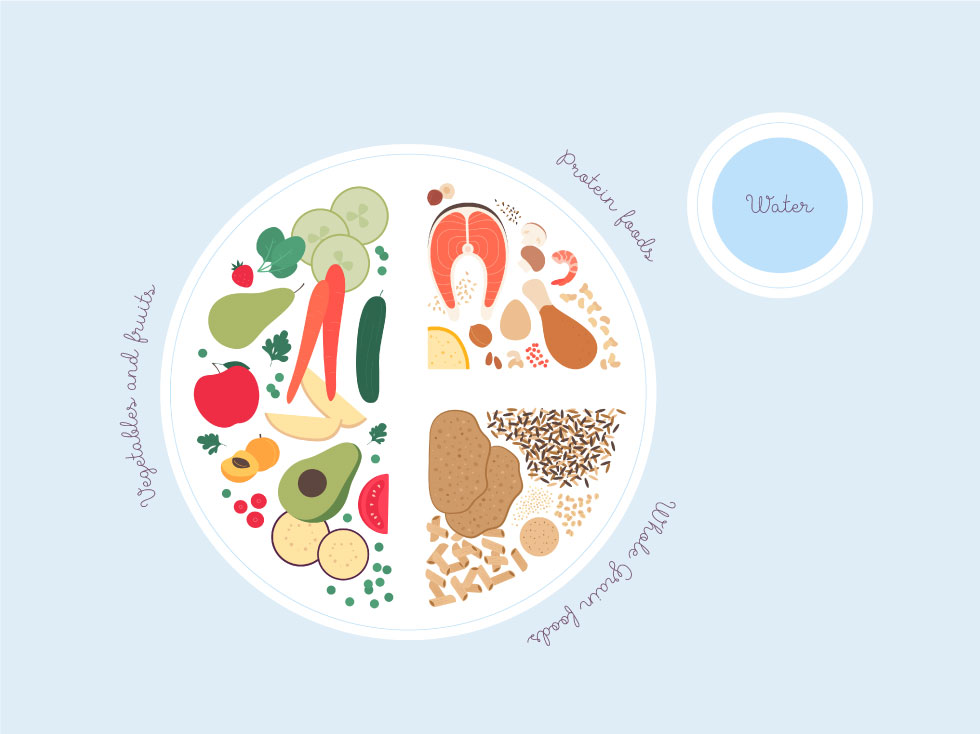
What Makes A Meal Whole
We know that juggling jobs, kids and the demands of a busy, modern life often come at the expense of family mealtime at home. As your grocer, we’re your ally—the solution to your mealtime dilemma. Have you ever heard of MyPlate? MyPlate can help you break down the science of mealtime by looking at if you’re incorporating all the parts of a meal that have nutritional benefit. By having a home-cooked meal, it can help nourish the spirit, brain and health of all family members. So let’s break it down by the categories:
Dairy: includes milk, yogurt, cheese, lactose-free milk and fortified soy milk and yogurt. Dairy intake depends on a variety of factors like stage of life, gender, height, weight and level of activity. The type of dairy be it whole, 2%, 1% or 0% changes with lifestyle and where you are in the world. You’ll mainly hear that dairy is great for helping to build strong bones. It can do this by these wonderful nutrients: calcium, potassium, vitamin D, and protein. It also has a slew of other important nutrients like: phosphorus, vitamin A, riboflavin, vitamin B12, potassium, zinc, magnesium, and selenium.
Proteins: All foods made from seafood; meat, poultry, and eggs are considered proteins. Other foods like beans, peas, lentils, nuts, seeds, and soy products are part of the Vegetable food group but are considered protein rich in their category which are an excellent option for our plant-based, vegetarian, or vegan shoppers. With every category, it’s important to consume a variety of different proteins to vary up nutrient content. We suggest sticking with lean options like 93/7 ground beef, 99% fat free chicken and turkey, fish, pork loin, eggs, skinless chicken breast and so on. Your protein needs vary from person to person and it is important to talk with your doctor and dietitian before changing your diet drastically. Vitamin B, vitamin E, zinc, iron, and magnesium are just a few of the nutrients you will find more present in this category.
Grains: Any food made from wheat, rice, oats, cornmeal, barley, or another cereal grain is a grain product. Bread, pasta, breakfast cereals, grits, and tortillas are examples of grain products. Foods such as popcorn, rice, and oatmeal are also included in the Grains Group! The important part we want you to take away here is to make at least half of your grain choices whole grains. The B vitamins, complex carbohydrates, and fiber really shine in this food category. B vitamins are known for their energy boosting ability. To go a little further, it’s the job of B vitamins to help the body convert food into energy, create new blood cells, and maintain healthy skin cells, brain cells, and other body tissues
Fruits: Eating fruit provides several different health benefits. People who eat more fruits and vegetables as part of an overall healthy diet are likely to have a reduced risk of some chronic diseases. Fruits provide nutrients vital for health and maintenance of your body. Most fruit options are low in fat, sodium, calories and have no cholesterol. Fiber is yet again another main function here with fruit on top of having a slew of different micronutrients like folate, vitamin c and potassium. Fiber helps reduce blood cholesterol levels, keep you feeling fuller longer, lower risk of heart disease, important for proper bowel function. Try and make as many of your sources whole sources.
Vegetables: All vegetables count here weather they are freeze-dried, frozen, canned, fresh, dried and so on. Fiber yet again takes center stage as to why it’s so important to consume them. The amount of vegetables you need varies on you as an individual but the general rule of thumb for an adult is 5-9 servings. A serving is 1 cup raw or ½ cup cooked. Most vegetables are naturally low in fat and calories and include a wide range of nutrients like vitamin a, vitamin k, polyphenols, antioxidants and much more. It’s important to note that eating a wide variety is key. Think color to get you started!
